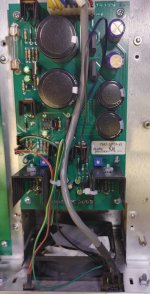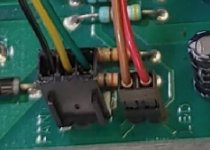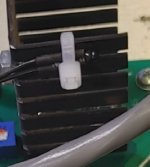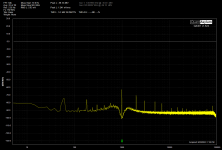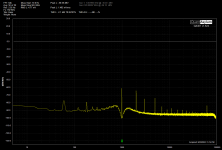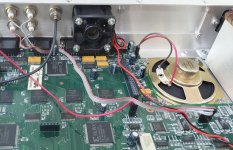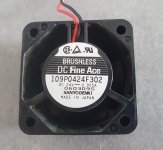Its a good history. . . One thing to watch, a lot of the interfaces are targeted at memory cards. They may not work at all. The APIB ISA interface (both cards) seems to use I/O and no interrupts. And the addressing is ISA which some hardware doesn't support since its soooo obsolete.
My experiece replacing the annoying fan in the AP-S1.
It turns out to not be too difficult. First get one of these: ARCTIC F8 TC - 80 mm Case Fan https://www.amazon.com/dp/B0037AUS4S?psc=1&ref=ppx_yo2ov_dt_b_product_details Its a temperature controlled fan (slows down when cold) that is an exact fit and has the same specs as the original fan (also available from Jameco still but why?) Its also at least 20 dB quieter.
Disconnect the cables and power cord (you will be working close to the power) Turn it over and open the bottom and remove the center shield to expose the fan. The fan has magnetic shields on the front and back (odd flat pieces of steel blocking some airflow). These are important since the fan can radiate a lot. They need to go back. The fan is held in place with two screws. They can be hard to remove. I think there is locktite on the threads. The nut lower inside is challenging to reach. The new fan has a 3 pin connector for power. You can ignore the third pin and it reaches and plugs in where the old one came out. Insert with black on the same pin that was black. I attached the thermistor to one of the larger heat sinks assuming its a suitable hot spot.
Pictures attached.

It turns out to not be too difficult. First get one of these: ARCTIC F8 TC - 80 mm Case Fan https://www.amazon.com/dp/B0037AUS4S?psc=1&ref=ppx_yo2ov_dt_b_product_details Its a temperature controlled fan (slows down when cold) that is an exact fit and has the same specs as the original fan (also available from Jameco still but why?) Its also at least 20 dB quieter.
Disconnect the cables and power cord (you will be working close to the power) Turn it over and open the bottom and remove the center shield to expose the fan. The fan has magnetic shields on the front and back (odd flat pieces of steel blocking some airflow). These are important since the fan can radiate a lot. They need to go back. The fan is held in place with two screws. They can be hard to remove. I think there is locktite on the threads. The nut lower inside is challenging to reach. The new fan has a 3 pin connector for power. You can ignore the third pin and it reaches and plugs in where the old one came out. Insert with black on the same pin that was black. I attached the thermistor to one of the larger heat sinks assuming its a suitable hot spot.
Pictures attached.
Attachments
Demian, I just acquired an almost-new ATS-2 (can't stay away from these critters!) witch has a very loud fan, probably because it has been sitting still for years. After several hours of runtime, still very loud.
It's a 40mm one. I will dismantle it (easy in the ATS-2 since it has only a single level board) and see what it says.
Jan
It's a 40mm one. I will dismantle it (easy in the ATS-2 since it has only a single level board) and see what it says.
Jan
Attachments
@jan.didden These small but thick Sanyo Denki are typically very loud (and very reliable), they are commonly used in hot-pluggable server power supplies (12V versions).
40mm fans are also commonly used as hotend coolers on 3D printers, for noise reasons people often use Sunon Maglev fans, like e.g. https://eu.mouser.com/ProductDetail/Sunon/MF40202V1-1000U-A99?qs=EU6FO9ffTwfwgUzmGzL%2BLg== . By specs it's 37dB vs. 25dB (CFM 11 vs. 9). Also when reducing the voltage/rpms (with a resistor to avoid another switcher), the noise will drop a lot, especially with the grommets.
40mm fans are also commonly used as hotend coolers on 3D printers, for noise reasons people often use Sunon Maglev fans, like e.g. https://eu.mouser.com/ProductDetail/Sunon/MF40202V1-1000U-A99?qs=EU6FO9ffTwfwgUzmGzL%2BLg== . By specs it's 37dB vs. 25dB (CFM 11 vs. 9). Also when reducing the voltage/rpms (with a resistor to avoid another switcher), the noise will drop a lot, especially with the grommets.
There are 2 types of noise from ventilators :
1. Vibrational noise amplified by "hard" acoustic connection to a thin sheet metal enclosure
2. Wind / Jet noise
Grommets are wonderful for reducing (1).
To reduce 2, the only way is to increase size of the ventilator and reduce velocity.
Same argument for using larger bass-reflex pipes.
Patrick
1. Vibrational noise amplified by "hard" acoustic connection to a thin sheet metal enclosure
2. Wind / Jet noise
Grommets are wonderful for reducing (1).
To reduce 2, the only way is to increase size of the ventilator and reduce velocity.
Same argument for using larger bass-reflex pipes.
Patrick
2 of these will give you 11 CFM at 24V, and 21dB(A).
https://cdn-reichelt.de/documents/datenblatt/E910/NOCTUA_NF-A4X20-FLX_DB-DE.pdf
Need to cut some holes.

Patrick
https://cdn-reichelt.de/documents/datenblatt/E910/NOCTUA_NF-A4X20-FLX_DB-DE.pdf
Need to cut some holes.
Patrick
If the 40mm Noctua fetches over 9CFM at 15dB, it looks more suitable than the Sunon. On the other hand it has less than half of the static pressure... On the other hand there is no resistance behind the fan on the outside, open space, tiny grill...
Both are inexpensive, maybe trying the more silent Noctua first and if it does not keep up, going for the Sunon.
Both are inexpensive, maybe trying the more silent Noctua first and if it does not keep up, going for the Sunon.
The Noctua fans are fantastic. I replaced four 40 mm fans in a network switch with Noctua ones. The switch went from being nearly intolerable to be in a room with to hardly emitting more than the sound of the air flowing through it. The only drawback was that the Noctua spin slower so the switch thought the fans were broken and gave me a yellow warning light. It never overheated, though, so I just learned to live with the yellow light.
Tom
Tom
- Home
- Design & Build
- Equipment & Tools
- Audio Precision System Sys1 USB Interface
